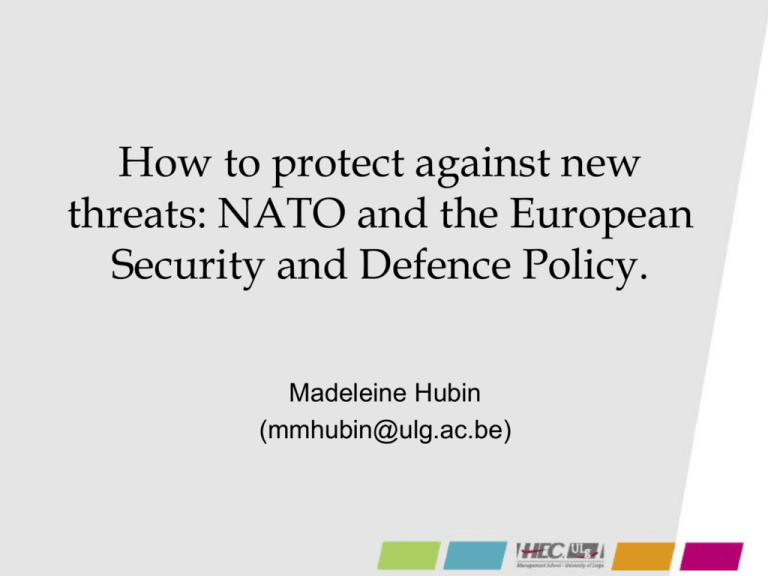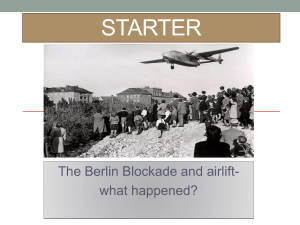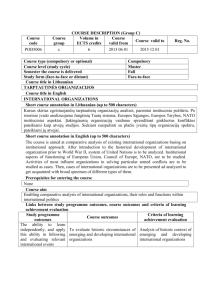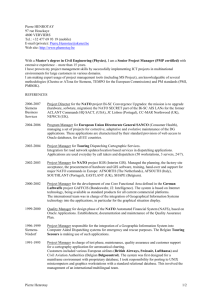Document
advertisement

How to protect against new threats: NATO and the European Security and Defence Policy. Madeleine Hubin (mmhubin@ulg.ac.be) A. NATO 1. Origin 2. NATO after the collapse of communism 2.1. Evolution of NATO 2.2. Enlargement 2.3. War in Kosovo 2.4. NATO after 9/11: Afghanistan 2.5. NATO and the war in Iraq 2.6. Over the past years 3. NATO today: a new strategic concept 1. Origin of NATO • • Beginning of the Cold War : « We are scared » Signature of the Treaty 4 April 1949 : – Basis : article 5 – Importance of article 4: The Parties will consult together whenever, in the opinion of any of them, the territorial integrity, political independence or security of any of the Parties is threatened. • Warsaw Pact: 1955. Menace Rouge Art 5 of the North Atlantic Treaty The Parties agree that an armed attack against one or more of them in Europe or North America shall be considered an attack against them all and consequently they agree that, if such an armed attack occurs, each of them, in exercise of the right of individual or collective selfdefence recognised by Article 51 of the Charter of the United Nations, will assist the Party or Parties so attacked by taking forthwith, individually, and in concert with the other Parties, such action as it deems necessary, including the use of armed force, to restore and maintain the security of the North Atlantic area. Art. 5 (cont.) Any such armed attack and all measures taken as a result thereof shall immediately be reported to the Security Council. Such measures shall be terminated when the Security Council has taken the measures necessary to restore and maintain international peace and security. A Divided Europe 2. NATO after the collapse of Communism 2.1. Evolution of NATO Reasons for the persistence of NATO • Basic mission of NATO still true : « Keep the Americans in, the Germans down and the Russians out ». • Willingness to keep an institutional framework for transatlantic relations. • Habit of cooperating within NATO and difficulty in creating new institutions. • NATO’s appeal to new democracies. • Unexpected adaptability of the organisation. • Regional tensions in Europe. The armies of NATO in the 90s. • Budgetary cuts. • Professionalisation of the army in some States. • Downsizing of armies. • Deeper technological gap with the USA. Missions of NATO in the 90s. • Peacemaking and peacekeeping operations: – Deliberate Force Non-article 5 missions Out-of-zone missions Peace-keeping/ making missions – I(mplementation)FOR then S(tabilization)FOR – New threats: Weapons of mass destruction International terrorism A new strategy: Co-operative security • Definition : « All the common means thanks to which potential enemies prevent, settle, reduce, contain or face threats which could lead to a war among themselves » • Extension : Principle of co-operation between the member States and international organisations to promote peacekeeping or peacemaking. • Example: Bosnia : Dialogue between the parties in conflict and – NATO : Peacekeeping – OSCE : Organisation of elections – Council of Europe : State – European Union : Economic development Framework for co-operation with the European States • North Atlantic Co-operation Council (1991): Forum for consultation and cooperation between NATO and non-member-countries in the Euro-Atlantic area. • Partnership for Peace (1994): assists participating countries in restructuring their armed forces to enable them to play their role at home and in NATO-led peace-keeping operations. • Mediterranean Dialogue (1995) • Euro- Atlantic Partnership Council (1997) 2.2. Enlargement • At first, wait and see (1991 – 1997) • Then, limited enlargement (July1997 – March 1999) with the admission of Poland, Hungary and the Czech Republic on 16 March 1999 • 23 March: start of « Allied force » operation in Kosovo. (air campaign: 78 days) • Afterwards, greater enlargement (negotiations Dec. 2002 until April 2004…): Slovenia, Slovakia, Romania, Bulgaria, Lithuania, Latvia and Estonia. • April 2009: Croatia and Albania. Questions raised by the enlargement • Why enlarge ? • What added value do the new member states bring NATO ? • What new problems or dangers do new member States bring NATO? • What are the terms for new admissions ? • What will be the reaction of third parties (mainly Russia) ? • At what cost for NATO ? Questions (cont.) • At what cost for new member States ? • How to make the present Alliance members agree with enlargement? • How to enlarge ? – Who ? – When ? – Consequences on the military plans ? Enlargement principles • The new members are willing and able to assume the responsibilities and obligations of membership and accept the policies and processes implemented at the time of admission. • No State will be admitted if it aims to close the door behind itself, by using its vote to veto other admissions. • The states must settle their ethnic problems as well as their border disputes before joining NATO. Principles (cont.) • The candidates must be able to contribute to the missions of the Alliance (No « profiteers »). • No third party is entitled to interfere in the enlargement process. (Russia) 2.3. War in Kosovo : consequences • Intervention out of the UN framework (new). • Obvious technological gap between the European and American armies. • Objective of the operation: « zero casualty ». • New member States take part just after joining NATO. • Differences among the allies on the way to operate : The Americans do not want to go to war collectively. The Europeans want to develop their own capabilities. At first, 43,000 troops were sent. In October 2004, there were 18,000 soldiers from most NATO members, 9 partner countries and 2 non-NATO countries (Argentina and Morocco). Russia took part in SFOR and KFOR until summer 2003. Washington Summit (1999) • Celebration of the Alliance’s 50th anniversary in the middle of the war in Kosovo. • Adoption of a new strategic concept which emphasises the new missions of NATO against new threats (multidirectional and often hard to predict): – Balkans – Focus on weapons of mass destruction – Terrorism, organized crime, sabotage, threat to flow of vital resources. • Launch of the Membership Action Plan (advice, aid, support in political, economic and legal fields + security) • Establishment of a WMD Center Adoption of the Defence Capabilities Initiatives (DCI) • Enhanced mobility and deployability beyond NATO territory. • Sustainability: the forces must be able to carry out long operations. • Survivability: ability to protect forces and infrastructure against present and future threats. • DCI Domains: Command – Control – Communications – Intelligence – Surveillance- Target Acquisition – Reconnaissance - Strategic transport - Suppression of enemy air defence Cuts in defence budgets Priorities have evolved : • Staff cuts. • Resources are transferred to the modernization of the equipment. • Co-operation on a multinational basis whenever possible. • Resources are put in common. • Specialization. 2.4. NATO after 9/11: Afghanistan • Article 5 enforced : Europe assists the US. Luxembourg radar aircraft sent. Refusal to use NATO structures for the operations in Afghanistan US preference for an ad hoc coalition. • Use of NATO in the war against terrorism ? National reaction first. • NATO leads the operations of ISAF (international security assistance force) in Kabul in 2003. NATO can operate outside Europe. • ISAF today = coalition of 48 countries deployed under UN authority (see ISAF doc.) Prague Summit (2002) • • • • « Prague Capabilities Commitment » - PCC Streamlined command structure. Stronger commitment to combating terrorism. Set-up of a Response Force of up to 21,000 soldiers for crisis-management operations until 2006. Technologically advanced, flexible, deployable, interoperable and sustainable force (land, sea, air elements). Objectives of PCC • Defending against chemical, biological, radiological and nuclear attacks. • Ensuring secure command, communications and information superiority. • Improving interoperability of deployed forces and key aspects of combat effectiveness. • Need for global partners. • Providing comprehensive political, economic and military solutions with NGOs, the UN and the EU, the OSCE etc. 2.5. NATO and the war in Iraq • Divisions among Alliance members. • Decision-making process stopped, no consensus. • NATO supports the multinational division under Polish command. • No NATO-banner troops occupying Iraq • NATO training mission since 2004: training security forces, developing security institutions, reform of defence in Iraq. Istanbul Summit (28-29 June 2004) • NATO will widen its mission of International Security and Assistance Force (ISAF) with the establishment of several additional Provincial Reconstruction Teams (PRT). It will also strengthen its support for elections. • NATO will end its mission in Bosnia-Herzegovina where it will be replaced by an EU force. However, the latter will be supported by NATO. (cont.) • Enhancing measures against terrorism : – Improving intelligence sharing – Quicker response to CBRN attacks – Providing assistance to protect major events (Euro 2004, Olympic games) – Enhancing co-operation among partners • Enhancing the Mediterranean Partnership. • Istanbul Co-operation Initiative with the Middle East designed to promote bilateral co-operation between NATO and interested parties in the region, the Gulf countries, for instance. Bahrain, Qatar, Kuwait, UAE: crisis management, civil emergency planning and border control. 2.6. Over the past years Riga Summit 2006 • Differing strategic interests between US and Europe. (315,000 > 40,000 US soldiers in Poland, Bulgaria and Romania) • 2005 – 2006: 8 simultaneous military out-of-zone operations (EUCOM covers 91 States). • Modernisation of the Alliance’s forces. • Afghanistan: no increase in troops. • Enhanced cooperation with non-member states. • Adoption of the Global Policy Directive (recognition of the role of the EU in terms of international security). Riga Summit (2) • NATO remains an essential place for political consultation as well as a forum to help standardize the tools and processes of joint military action. • Consensus in question. • Main threats: terrorism and WMD proliferation. • Main risks and challenges: instability of failed states, regional crises and conflicts, increased availability of conventional weapons, diversion of emerging technologies, distortion in supplies of vital resources. Riga Summit (3) • To combat those threats, NATO must be able to deploy troops everywhere in the world for long periods of time and lead several operations simultaneously, by using a combination of conventional and nuclear forces. • Differing views: US (NATO = world security organisation) >< most European countries (NATO = strictly military organisation, want to rely on the UN and the EU to face crises in the world) Bucharest Summit 2008 • Croatia and Albania allowed to join the alliance in 2009. • Former Yugoslav Republic of Macedonia: accession vetoed by Greece (name dispute). • Ukraine and Georgia: accession postponed indefinitely (by France and Germany, against the will of the USA). • NATO will back the construction of the US missile defence system in Poland and the Czech Republic. • Gap between western and eastern Europe: distance vs guarantee. • France: returning to Integrated Command in 2009. • Afghanistan: need for more troops, debate about more involvement. Strasbourg Summit (April 2009) • 60th anniversary of NATO • Two new member States: Albania and Croatia. • New Secretary General as of 1st Aug. (A.F. Rasmussen replaces J. de Hoop Scheffer). • France is back in Allied Command (which de Gaulle had left in 1966 to protest against US domination). France wants European headquarters in Brussels. • Afghanistan: strategic support of the US, 5,000 additional troops (compared with 17,000 extra troops, and 4,000 instructors for the US alone). • Russia: the NATO-Russia Council is back at work (suspended in August 2008 bec. of crisis in Georgia). Common issues: security, stabilisation in Afghanistan, fight against terrorism, drugs and piracy, nonproliferation and disarmament. • Russia: love-hate relationship … Two Russians spies expelled from NATO, two Canadian diplomats expelled from Russia … Need for reinforcing cooperation and relations, for new trust. • Russia wants to contribute to the US anti-missile defence system. Burden sharing in NATO • Contribution < national sovereignty. • Burden-sharing mechanism: 2% of GDP to pay for the NATO operations. ( would represent $ 67 bn). Not met (5/28). • Fragmentation of the defence sector in Europe > unnecessary duplication, unhelpful competition, gaps or incompatibilities. • In Afghanistan: other actors should share the burden: G8 States, UN, Afghan government. • Capabilities, money and political will. 3. NATO today : a new strategic concept • Active engagement, modern defence • 3 essential core tasks: A. Collective defence - Deterrence: appropriate mix of nuclear and conventional capabilities. - Threats: proliferation of ballistic missiles and nuclear weapons, terrorism, cyber attacks, fundamental environmental problems, resource constraints B. Crisis management Political and military tools: prevent, manage, stabilise and support. C. Cooperative security Partnerships with other States or international organisations. Reinforcement of arms control, disarmament, nonproliferation efforts. • Emphasis on Alliance solidarity, importance of transatlantic consultation and need to engage in a continuous process of reform. • Open-door policy. • Maximising efficiency, improving working methods and spending its resources more wisely. B. The European Security and Defence Policy Plan 1. Historical background up to 1998. 2. The golden age of the ESDP: principles, actors, a few missions, European difficulties. 3. Civilian crisis management. 4. The Solidarity clause. 5. New challenges: - lessons learnt from the Iraq crisis - evolution of the approaches - technology and finance - the European Security Strategy : a failure? 1. Historical background up to 1998 The Western European Union • Specific European initiative on defence: Brussels Pact 1948 (Benelux, France and the UK). • Forerunner of NATO. • Objective: to deter German revanchism. • Article 5: if one of the members is attacked in Europe, the other members will bring aid and assistance with all possible means, military and others (// art 51 of the UN Charter). • 1949: the WEU’s defence functions subsumed into NATO. • Considered as the European pillar of NATO then as the security wing of the EU. Other defence initiatives • European Defence Community (1952-1954): Pleven Plan. Benelux, France, Italy, Germany. The French failed to ratify. • Fouchet plan in the 1961: draft treaty for a political community. Failed in 1962, lack of supra-nationalism. • 1970: Davignon Plan on European Political Cooperation. External policy Co-operation meetings of foreign ministers. • Organisation for Security and Cooperation in Europe: (1994) active in the early warning conflict prevention, in crisis management and post-conflict rehabilitation. - 56 Member States from 3 continents. - Created in the early 1970s as a multilateral forum for dialogue and negotiation between the two blocks. - Three-fold dimension to security: political and military; economic and environmental; human. - Areas of activity: preventive diplomacy, conflict prevention, democratization, human rights, arms control, economic and environmental security … Treaty of Maastricht (1992) •Creation of a Common Foreign and Security Policy. •No proper military capacities > Western European Union. •CFSP decisions are still subject to unanimous votes. June 1992: Petersberg Declaration: Missions • Humanitarian and rescue tasks (of nationals). • Peacekeeping tasks. • Tasks of combat forces in crisis management, including peacemaking or peace-enforcement. • Military and civilian crisis management. • Collaboration with NATO: avoid duplication and target specific gaps. Treaty of Amsterdam (1997) • Incorporated the Petersberg missions. • High Representative + Policy Planning and Early Warning Unit. • Development of the European Security and Defence Policy. • No European army. National armies remain under the command of national authorities except for the duration of the mission. Evolution • Evolution of the attitude of the so-called "neutral" States (Austria, Finland, Ireland, Sweden), which now accept to engage militarily in crisis management. • Evolution of Germany which starts using an army again in its foreign policy. • Evolution of France which at the time focuses less on building a powerful EU independent from the US. • General awareness in Europe, following the crises in Bosnia and Kosovo, of the collective inability to act without the USA, which led either to the absence of any action, or to the US command of operations. 2. The golden age of the ESDP • Saint Malo (1998): Blair (UK) and Chirac (F) emphasis on an autonomous action capability supported by credible armed forces (Bosnia, Kosovo). • Cologne Summit (1999): Definition of a Common Defence Strategy. Official launching of ESDP. Global Helsinki Objective (1999) “Co-operating voluntarily in the framework of EU-led operations, the member States will have to be able by 2003, to deploy within 60 days, and sustain for at least one year, up to 60,000 people able to achieve the Petersberg missions". • Set up of a common crisis management tool: ESDP. Main idea behind the ESDP • The Union wants to assert its identity on the international scene, in particular through the implementation of a Common Foreign and Security Policy, including the progressive framing of a Common Defence Policy, which might lead to a common defence … Principles • Intervention of the European Union for crisis management, not collective defence. • Intervention of the Union when NATO is not present as such. • Action within the EU’ s institutional framework. • Creation of appropriate structures within the European Union. • Collaboration with the WEU for capacity of crisis assessment, intelligence gathering and strategic planning capacity. Principles • Possibility to resort to NATO means. • Strengthening of the armed forces of the member States. • Capacities supplied by each member State individually and on a voluntary basis. • Possible participation of non-EU member States in EU crisis management (promotion of international co-operation). Actors • • • • • European Council, Council of Foreign Affairs Ministers, High Representative of the CFSP, Political and Security Committee, CFSP Working Group and CFSP Counsellors • Influence of the Commission and the European Parliament. • Treaty of Nice (2000) : formalised the Union’s capacity to manage crises outside its territory + its engagement in peacekeeping and peace enforcement. • Transfer of competences from the WEU to the EU. • New military structures : – The political and Security Committee (PSC) – The Military Committee (EUMC) – The Military Staff (EUMS) – The Committee for Civilian aspects and Crisis Management – Agencies : • Satellite Centre of Torrejon • Institute for Strategic Studies (Paris) A few missions of ESDP • EU police mission in Bosnia-Herzegovina (20032007) • Operation "Concordia" in the Former Yugoslav Republic of Macedonia. (2003) Military operation, 350 troops. • Operation « Proxima » : police in FYRM. (2003-2004) • Operation "Artemis" in the Democratic Republic of Congo. (2003) Military crisis mgt. • EUJUST “Themis”: Georgia (rule of law).(2004-2005) • EUFOR “Althea”: Bosnia, replacing NATO. (since 2004) • Atalanta: off the coasts of Somalia: piracy European difficulties • • • • • Strategic transport (air and sea) Air re-supplying Intelligence Protection of troops Military electronics • Precision ammunitions : distance shooting 3. Civilian crisis management: four mutually dependent instruments • Police co-operation: poss. of providing up to 5,000 policemen, restoring order, training local police (1,000 deployable in 30 days) • Strengthening the rule of law: up to 200 judges, or prosecutors and experts. • Civilian administration: team to establish or guarantee elections, taxation, education, water provision, … • Civil protection: assisting humanitarian actors through emergency operations. Assessment and intervention teams. Civilian crisis management: objectives • Working to prevent conflicts from emerging or intensifying. • Consolidating peace and internal stability in transition periods. • Guaranteeing complementarities between the civilian and military aspects of crisis management so as to cover the range of the Petersberg missions. 4. Solidarity Clause (EU Constitution) 1. The Union and its Member States shall act jointly in a spirit of solidarity if a Member State is the victim of terrorist attack or natural or man-made disaster. The Union shall mobilize all the instruments at its disposal, including military resources made available by the member States, to: - prevent the terrorist threat in the territory of the Member States; - protect democratic institutions and the civilian population from any terrorist attack; - assist a Member State in its territory at the request of its political authorities in the event of a terrorist attack; - assist a Member State in its territory at the request of its political authorities in the event of a disaster. NB: The European Constitution was rejected by France and the Netherlands… 5. New Challenges: Lessons from the Iraq crisis • The success of European Foreign Policy still depends very much on the extent to which the national foreign policies of its most influential Member States coincide. • Need for the Union to think of itself as a global actor in the international arena. It must become a provider of external security, but not the world’s policeman. • Need for an effective military capability. • Dec. 2003: EU defines itself as an autonomous geopolitical actor in its European Security Strategy. Evolution of the approaches to crises • • • • During the Cold War: nuclear weapons, bipolar world. Today: either conflict which may lead to a war, or crisis after an aggression (non-state actor as in terrorism). Act of terrorism: first national reaction. Preventive action and retaliation. Technology and finance • Technological gap but European know-how. • Role of the defence industry (mergers, partnerships) but no political decision power. • Finance: US: 43% of global defence spending, EU 27: 19.4% (501 m. inhabitants)! NB: F and UK: 2.32% of GDP, Poland: 1.66%, Italy: 1.44%, Germany: 1.27%, Spain: 1.16%. • Problems: bureaucracy, rivalry between armies, national budget pressures… The European Security Strategy • Response to: terrorism, proliferation of WMD, regional conflicts, state failure, organised crime + climate change, energy security, financial stability, cyber-war. • Make the EU more responsive and timely. • Increased emphasis on conflict prevention and resolution. • Prioritisation: need to clearly set priorities in terms of place, importance and intensity. A failure? • Strategy: lack of originality, no clear threat, little military view. • 2004: UK elections (Euroskeptics are back). • 2005: EU existential crisis following the rejection of the constitutional treaty by F and NL. • Unanimity rule = problem. • No willingness for collective defence. • Structural equipment deficit. • No planning and operating power/ structure. • Difficult ratification of the LisbonTreaty (2010): EU members will only act in accordance with their commitments within NATO. • Permanent Structured Cooperation: for the willing (// EMU) or BIG-6 Project (F, G, UK, I, Sp, Pol), a pioneer group of 60,000 troops. Useful? • Solution: one voice, something to say and the necessary means to be credible. C. Conclusion: NATO and the EU • NATO = security organisation based on a political alliance between independent States. Ad hoc coalitions, multi-partnership. • EU = political, economic, trade, monetary entity which unites States in their most fundamental interests. • Different states of completion and no parallel. NATO-EU Cooperation • Manoeuvres, common operations, common standards. • Europe needs strategic autonomy + financial means. • Problem: law and force, legitimacy. • Cooperation is recognized. • Complementarity is necessary. • Military means must be compatible. NATO – EU cooperation • Action zones: geographical proximity is fundamental. Efficiency area: time to react, projection capacity and capacity to sustain/ last. • Various battle zones: diversity > flexibility and adaptability. • How may combat operations affect subsequent reconstruction operations? • Afghanistan, Libya, … • Bottom-up approach. Questions? Thank you!








